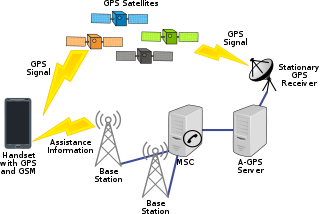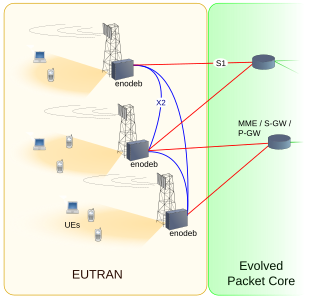Related Research Articles

General Packet Radio Service (GPRS), also called 2.5G, is a packet oriented mobile data standard on the 2G cellular communication network's global system for mobile communications (GSM). GPRS was established by European Telecommunications Standards Institute (ETSI) in response to the earlier CDPD and i-mode packet-switched cellular technologies. It is now maintained by the 3rd Generation Partnership Project (3GPP).
The Universal Mobile Telecommunications System (UMTS) is a third generation mobile cellular system for networks based on the GSM standard. Developed and maintained by the 3GPP, UMTS is a component of the International Telecommunication Union IMT-2000 standard set and compares with the CDMA2000 standard set for networks based on the competing cdmaOne technology. UMTS uses wideband code-division multiple access (W-CDMA) radio access technology to offer greater spectral efficiency and bandwidth to mobile network operators.
Non-access stratum (NAS) is a functional layer in the NR, LTE, UMTS and GSM wireless telecom protocol stacks between the core network and user equipment. This layer is used to manage the establishment of communication sessions and for maintaining continuous communications with the user equipment as it moves. The NAS is defined in contrast to the Access Stratum which is responsible for carrying information over the wireless portion of the network. A further description of NAS is that it is a protocol for messages passed between the User Equipment, also known as mobiles, and Core Nodes that is passed transparently through the radio network. Examples of NAS messages include Update or Attach messages, Authentication Messages, Service Requests and so forth. Once the User Equipment (UE) establishes a radio connection, the UE uses the radio connection to communicate with the core nodes to coordinate service. The distinction is that the Access Stratum is for dialogue explicitly between the mobile equipment and the radio network and the NAS is for dialogue between the mobile equipment and core network nodes.
The GPRS core network is the central part of the general packet radio service (GPRS) which allows 2G, 3G and WCDMA mobile networks to transmit Internet Protocol (IP) packets to external networks such as the Internet. The GPRS system is an integrated part of the GSM network switching subsystem.
The Radio Network Controller (RNC) is a governing element in the UMTS radio access network (UTRAN) and is responsible for controlling the Node Bs that are connected to it. The RNC carries out radio resource management, some of the mobility management functions and is the point where encryption is done before user data is sent to and from the mobile. The RNC connects to the Circuit Switched Core Network through Media Gateway (MGW) and to the SGSN in the Packet Switched Core Network.

Assisted GNSS (A-GNSS) is a GNSS augmentation system that often significantly improves the startup performance—i.e., time-to-first-fix (TTFF)—of a global navigation satellite system (GNSS). A-GNSS works by providing the necessary data to the device via a radio network instead of the slow satellite link, essentially "warming up" the receiver for a fix. When applied to GPS, it is known as assisted GPS or augmented GPS. Other local names include A-GANSS for Galileo and A-Beidou for BeiDou.
The air interface, or access mode, is the communication link between the two stations in mobile or wireless communication. The air interface involves both the physical and data link layers of the OSI model for a connection.
Multimedia Broadcast Multicast Services (MBMS) is a point-to-multipoint interface specification for existing 3GPP cellular networks, which is designed to provide efficient delivery of broadcast and multicast services, both within a cell as well as within the core network. For broadcast transmission across multiple cells, it defines transmission via single-frequency network configurations. The specification is referred to as Evolved Multimedia Broadcast Multicast Services (eMBMS) when transmissions are delivered through an LTE network. eMBMS is also known as LTE Broadcast.
RNSAP is a 3GPP signalling protocol responsible for communications between RNCs Radio Network Controllers defined in 3GPP specification TS 25.423. It is carried on the lur interface and provides functionality needed for soft handovers and SRNS relocation. It defines signalling between RNCs, including SRNC and DRNC.
SRNC | DRNC | IUR | RNSAP | RNSAP | | |

E-UTRA is the air interface of 3rd Generation Partnership Project (3GPP) Long Term Evolution (LTE) upgrade path for mobile networks. It is an acronym for Evolved UMTS Terrestrial Radio Access, also known as the Evolved Universal Terrestrial Radio Access in early drafts of the 3GPP LTE specification. E-UTRAN is the combination of E-UTRA, user equipment (UE), and a Node B.
Vertical handover or vertical handoff refers to a network node changing the type of connectivity it uses to access a supporting infrastructure, usually to support node mobility. For example, a suitably equipped laptop might be able to use both high-speed wireless LAN and cellular technology for Internet access. Wireless LAN connections generally provide higher speeds, while cellular technologies generally provide more ubiquitous coverage. Thus the laptop user might want to use a wireless LAN connection whenever one is available and to revert to a cellular connection when the wireless LAN is unavailable. Vertical handovers refer to the automatic transition from one technology to another in order to maintain communication. This is different from a horizontal handover between different wireless access points that use the same technology.
Packet Data Convergence Protocol (PDCP) is specified by 3GPP in TS 25.323 for UMTS, TS 36.323 for LTE and TS 38.323 for 5G. PDCP is located in the Radio Protocol Stack in the UMTS/LTE/5G air interface on top of the RLC layer.

High Speed Packet Access (HSPA) is an amalgamation of two mobile protocols—High Speed Downlink Packet Access (HSDPA) and High Speed Uplink Packet Access (HSUPA)—that extends and improves the performance of existing 3G mobile telecommunication networks using the WCDMA protocols. A further-improved 3GPP standard called Evolved High Speed Packet Access was released late in 2008, with subsequent worldwide adoption beginning in 2010. The newer standard allows bit rates to reach as high as 337 Mbit/s in the downlink and 34 Mbit/s in the uplink; however, these speeds are rarely achieved in practice.

Evolved High Speed Packet Access, HSPA+, HSPA (Plus) or HSPAP, is a technical standard for wireless broadband telecommunication. It is the second phase of HSPA which has been introduced in 3GPP release 7 and being further improved in later 3GPP releases. HSPA+ can achieve data rates of up to 42.2 Mbit/s. It introduces antenna array technologies such as beamforming and multiple-input multiple-output communications (MIMO). Beam forming focuses the transmitted power of an antenna in a beam towards the user's direction. MIMO uses multiple antennas at the sending and receiving side. Further releases of the standard have introduced dual carrier operation, i.e. the simultaneous use of two 5 MHz carriers. HSPA+ is an evolution of HSPA that upgrades the existing 3G network and provides a method for telecom operators to migrate towards 4G speeds that are more comparable to the initially available speeds of newer LTE networks without deploying a new radio interface. HSPA+ should not be confused with LTE though, which uses an air interface based on orthogonal frequency-division modulation and multiple access.
System Architecture Evolution (SAE) is the core network architecture of mobile communications protocol group 3GPP's LTE wireless communication standard.
The UMTS channels are communication channels used by third generation (3G) wireless Universal Mobile Telecommunications System (UMTS) networks. UMTS channels can be divided into three levels:

E-UTRAN Node B, also known as Evolved Node B, is the element in E-UTRA of LTE that is the evolution of the element Node B in UTRA of UMTS. It is the hardware that is connected to the mobile phone network that communicates directly wirelessly with mobile handsets (UEs), like a base transceiver station (BTS) in GSM networks.
OTDOA is a positioning feature introduced in rel9 E-UTRA. It's a multilateration method in which the User Equipment (UE) measures the time difference between some specific signals from several eNodeBs and reports these time differences to a specific device in the network. The ESMLC based on these time differences and knowledge of the enodeBs locations calculates the UEs' position.
In mobile telephony a bearer service is a link between two points, which is defined by a certain set of characteristics. Whenever user equipment (UE) is being provided with any service, the service has to be associated with a Radio Bearer specifying the configuration for layer 2 and physical layer in order to have its QoS clearly defined. Radio bearers are channels offered by Layer 2 to higher layers for the transfer of either user or control data. In other words, Layer 2 offers to the upper layers the service of information transmission between the UE and the UTRAN by means of the Radio Bearers (RBs) and Signaling Radio Bearers (SRBs). Therefore, the service access points between Layer 2 and upper layers are RBs.
Fast Dormancy, or FD, is a mobile technology feature designed to reduce battery consumption and network utilization between mobile devices and their respective carrier networks during periods of data inactivity. It is currently implemented by monitoring the activity level of the mobile device and setting it to a control channel and power state appropriate for its level of activity. Each state results in different power consumption and network throughput while allowing a consistent data connection to be maintained. It is standardized by the 3rd Generation Partnership Project (3GPP) and implemented by most mobile carriers as a standard feature. Fast Dormancy is required to be supported by both the device and the carrier network in order for it to function.
References
- ↑ "X.225 : Information technology – Open Systems Interconnection – Connection-oriented Session protocol: Protocol specification". Archived from the original on 1 February 2021. Retrieved 10 March 2023.
- ↑ 3GPP TS 25.331 Radio Resource Control (RRC); Protocol specification
- ↑ 3GPP TS 36.331 Evolved Universal Terrestrial Radio Access (E-UTRA); Radio Resource Control (RRC); Protocol specification
- ↑ 3GPP TS 38.331 NR; Radio Resource Control (RRC); Protocol specification
- ↑ UMTS RRC Protocol specification (version 12.4.0 Release 12) (PDF), European Telecommunications Standards Institute, February 2015
- 1 2 Pe´rez-Romero, Jordi (2005). Radio Resource Management Strategies in UMTS. John Wiley & Sons Ltd. p. 103. ISBN 0470022779 . Retrieved 10 April 2015.
- 1 2 Qian, Feng (November 2010). "Characterizing Radio Resource Allocation for 3G Networks" (PDF). Proceedings of the 10th ACM SIGCOMM conference on Internet measurement. Melbourne, Australia: ACM. pp. 137–150.
- 1 2 3 4 Henry Haverinen, Jonne Siren and Pasi Eronen (April 2007). "Energy Consumption of Always-On Applications in WCDMA Networks" (PDF). In Proceedings of the 65th Semi-Annual IEEE Vehicular Technology Conference. Dublin, Ireland.
- ↑ L. de Bruynseels, “Tuning Inactivity Timer Settings in UMTS”, white paper, Commsquare Ltd., 2005